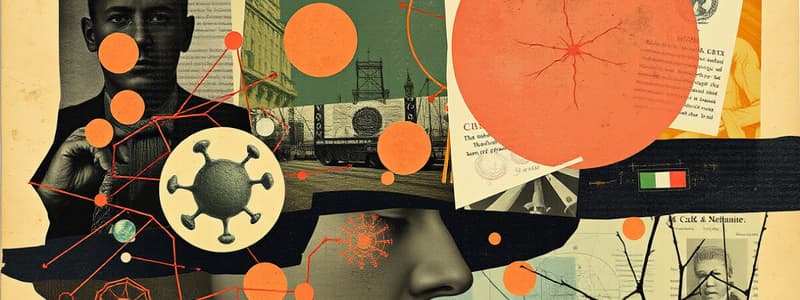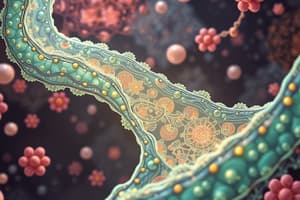Podcast
Questions and Answers
What is the key limiting factor on cell size?
What is the key limiting factor on cell size?
The size of a cell is limited by the ratio of its surface area to volume.
A cell will only remain stable if...
A cell will only remain stable if...
the surface area of the plasma membrane maintains a balance with the volume of the cytoplasm.
What does the salivary gland secrete?
What does the salivary gland secrete?
saliva
Who studied the relationships between traits expressed in parents and offspring?
Who studied the relationships between traits expressed in parents and offspring?
In order to become an established part of an island ecosystem, there must be...
In order to become an established part of an island ecosystem, there must be...
What are lymphocytes?
What are lymphocytes?
What do B cells produce?
What do B cells produce?
What role do T cells play in immunity?
What role do T cells play in immunity?
How do mass extinctions promote diversification?
How do mass extinctions promote diversification?
What are common elements found in proteins?
What are common elements found in proteins?
What phylum are snakes in?
What phylum are snakes in?
What is cellular respiration?
What is cellular respiration?
What is a hydrogen bond?
What is a hydrogen bond?
What does a hydrogen bond involve?
What does a hydrogen bond involve?
What do ionic bonds involve?
What do ionic bonds involve?
What do covalent bonds do?
What do covalent bonds do?
How are chimpanzees related to Homo sapiens?
How are chimpanzees related to Homo sapiens?
About five million years ago, what happened to the lineage leading to modern Homo sapiens?
About five million years ago, what happened to the lineage leading to modern Homo sapiens?
How can the evolution leading to Homo sapiens be described?
How can the evolution leading to Homo sapiens be described?
When did early hominids stand upright?
When did early hominids stand upright?
Did the large brain and upright posture of Homo sapiens evolve together?
Did the large brain and upright posture of Homo sapiens evolve together?
Where are most fossils of hominids found?
Where are most fossils of hominids found?
What does the stomach secrete?
What does the stomach secrete?
To which kingdom do algae and protozoa belong?
To which kingdom do algae and protozoa belong?
How do plants and animals obtain usable nitrogen?
How do plants and animals obtain usable nitrogen?
What state is reached when the water concentration inside and outside the cell is equal?
What state is reached when the water concentration inside and outside the cell is equal?
What are isotonic conditions produced by?
What are isotonic conditions produced by?
What happens to the reaction rate when substrate concentration increases in the presence of a limited amount of enzyme?
What happens to the reaction rate when substrate concentration increases in the presence of a limited amount of enzyme?
What is an enzyme?
What is an enzyme?
What is a catalyst?
What is a catalyst?
What does the kingdom Protista contain?
What does the kingdom Protista contain?
What does the kingdom Animalia contain?
What does the kingdom Animalia contain?
Flashcards are hidden until you start studying
Study Notes
Cell Size and Stability
- Cell size is limited by the surface area to volume ratio.
- Stability requires a balance between the surface area of the plasma membrane and the cytoplasm volume.
Digestive System Functions
- Salivary glands secrete saliva, aiding in the digestion process.
- The stomach produces digestive enzymes, hydrochloric acid, and gastric juices while mucous protects its lining.
Gregor Mendel and Genetics
- Studied inheritance patterns of traits in parents and offspring, foundational for genetics.
Ecosystem Establishment
- Successful island ecosystem integration requires a population large enough for reproduction, adequate food sources, suitable habitats, and moisture.
Immunity and Lymphocytes
- Lymphocytes are immunity cells produced in bone marrow.
- B Cells generate antibodies targeting foreign antigens.
- T Cells patrol blood and can destroy antigens, regulating immune responses.
Extinction and Diversification
- Mass extinctions open ecological niches, fostering the emergence of diverse species.
Molecular Composition of Proteins
- Proteins commonly contain carbon, hydrogen, oxygen, and nitrogen.
Taxonomy and Classification
- Snakes belong to the phylum Chordata.
- Kingdom Protista includes algae and protozoa, while Kingdom Animalia consists of multicellular eukaryotes like vertebrates and invertebrates.
Cellular Processes
- Cellular respiration is the process that releases energy for cellular use.
- Hydrogen bonds are weaker than ionic and covalent bonds, involve attraction between atoms of different polarity, and are easily broken.
- Ionic bonds involve electron transfer, while covalent bonds entail electron sharing.
Evolutionary Insights
- Chimpanzees are more closely related to Homo sapiens than other apes; however, humans did not evolve from them.
- A divergence between the lineages of modern Homo sapiens and chimpanzees occurred about five million years ago.
- Human evolution resembles branching trees rather than a linear ladder, with many simultaneous branches and dead ends.
- Early hominids walked upright before an increase in brain size, and the evolution of large brain and upright posture did not occur simultaneously.
Fossils and Distribution
- Most hominid fossils are found on continents outside of North America.
Nitrogen Acquisition
- Plants and animals obtain usable nitrogen through nitrogen-fixing bacteria and lightning.
Osmotic Balance
- Cells achieve an isotonic state when water concentrations inside and outside are equal.
- Isotonic conditions result from osmotic movement of water to equalize concentrations.
Enzymatic Reactions
- Substrate concentration affects reaction rates; increasing substrate leads to higher rates until enzyme saturation occurs.
- Enzymes are proteins that act as catalysts in organic reactions, while catalysts speed up reactions without altering themselves.
Studying That Suits You
Use AI to generate personalized quizzes and flashcards to suit your learning preferences.




